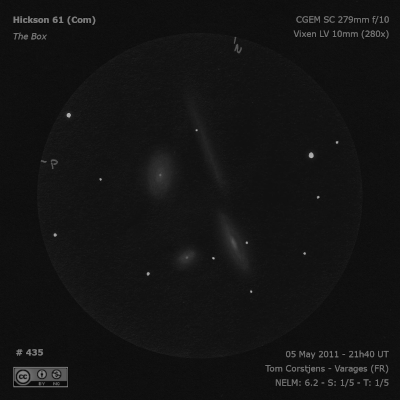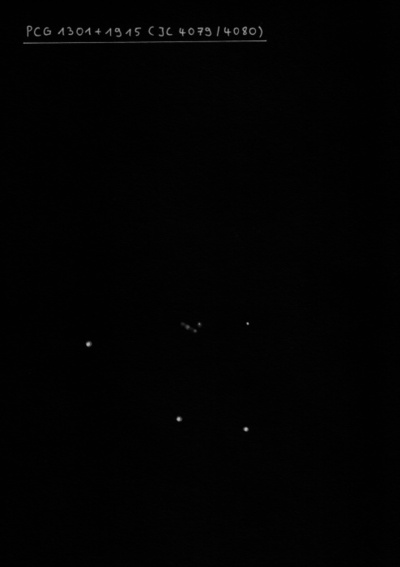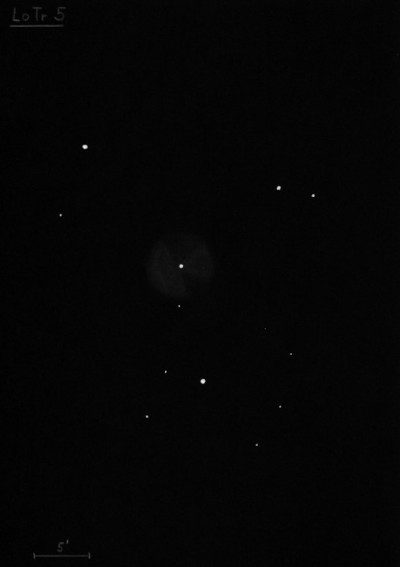A faint constellation of the northern sky covering the star-poor region between Leo and the Boötes. The constellation reflects the north pole of the Galaxy - the direction of the axis of rotation of our Galaxy, which lies in the sky near the star β Comae Berenices, and therefore we look in this direction perpendicular to the plane of the Galaxy. The Milky Way is far away, so we can expect to see a large number of distant galaxies. In addition, in the southwestern part of the constellation is the almost "unmissable" Coma-Virgo galaxy cluster, which is the heart of the local supercluster and our galactic neighborhood. It includes the so-called Coma Cluster, which brings together over 1 000 galaxies 300 to 400 million light-years away. Several of its brightest members can be well observed with a 200 mm telescope.
Of interest to the unaided eye is the diffuse cluster around the Coma Berenices galaxy γ - Melotte 111, which contains a collection of several fifth and sixth magnitude stars scattered over an area of five degrees, making it an ideal object especially for the binocular. The cluster lies only 280 light years away and is our third closest open cluster after the Big Dipper and Hyades groups. Altogether it contains 38 members up to 9.3mag over an area of twelve degrees, the brightest of which are the constellations 12, 13, 14, 16, 17, 21 and 34 Coma Berenices. Melotte 111 is 500 million years old and is not included in the Messier catalogue or the NGC.
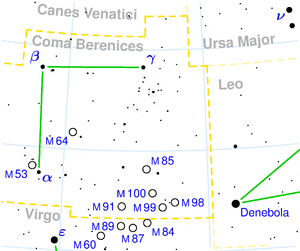
24 Com - Double star, components of 5.2 magnitude and 6.7 magnitude with a separation of 20.3". In at least a 10 cm telescope, a nice color contrast between the main yellow-orange and the fainter blue stars, similar to Albireo in Cygnus. Otherwise, they can be distinguished even with a better binocular.
Diadém (α Com) - The star, which appears as a point with a magnitude of 4.3 to the naked eye, is actually a binary star consisting of two components with a brightness of 5.1 magnitude. However, we cannot distinguish them with a small telescope. They orbit each other every 25.85 years.
2 Com - nice pair of two yellow components (5.9mag and 7.4mag). This binary star can be resolved with a telescope with an objective diameter larger than 10 cm at a separation of 3.7".
R Com - The variable star of Mira Ceti type with a magnitude fluctuation ranging from 7.1 to 14.6 in a period of 363 days.
Burnham 800 - A beautiful binary star, despite the unequal brightness of the orange component at 6.6 magnitude and the red component at 9.7 magnitude with a separation of 6.8". A star with a magnitude of 10.4 is located 92.5" north of the primary star. We need a high-quality telescope of at least 10 cm.
NGC 4565
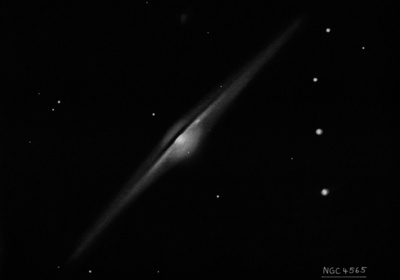
William Herschel discovered NGC 4565 = H V-24 = h1357 on 6 Apr 1785 (sweep 393) and recorded "a lucid ray with a vB spot in the middle. The ray about 20' long and about 3 or 4' broad; extended from np to sf, making an angle of about 35° with the meridian. The nebula makes a beautiful appearance." John Herschel made 4 observations and noted the fainter strip on the northeast side of the dust lane. On sweep 407 he recorded "vL; an immensely long ray; pos = 134.5° by micrometer. Both Lord Adare and Mr Hamilton, who viewed it with me, agreed that a feeble parallel band extends below (north) of the nucleus."
R.J. Mitchell, Lord Rosse's assistant on 17 Apr 1855 , remarked "a beautiful object, very well seen in finding eyepiece. The whole neb is much broader (taking into account the appendage) at Nucl than elsewhere, narrowing off suddenly and very symmetrically towards both ends, and the Nucl projects forward into the dark space; and immediately opposide this the faint appendage is broadest and brightest. The ray is 12' or 14' long and there is a faint star at Alpha [on diagram]. (Mr. J. Stoney was with me)"
300/350mm - 13.1" (5/26/84): the absorption lane is prominent at 100x and portion of the galaxy beyond fairly easy. A stellar nucleus is visible within the bright central bulge.
13.1" (5/14/83): fairly bright, very large thin streak, bright core. The dust lane is clearly visible to the north of the bright nucleus.
13.1" (4/24/82): a faint dark lane splits the central bulge into two unequal parts. The nucleus is brightest to the south of the lane. The strip of the galaxy on the north side of the dust lane is fainter.
400/500mm - 17.5" (3/28/87): bright, very large, edge-on 12:1 NW-SE, dimensions approximately 16'x1.5'. A beautiful dark lane is visible continuously with direct vision along most of major axis although more prominent in the center. The galaxy is split asymmetrically by the dust lane with the southern half both larger and brighter. Subtle scalloped structure is visible along the dust lane. Contains a small bright core with a stellar nucleus at the south edge of the lane. A mag 13.5 star is 1.6' NE of the center. A string of five mag 10-12.5 stars of length 11' oriented N-S is west of the galaxy and the southern end leads directly to NGC 4562, 13' SW of center.
900/1200mm - 48" (2/19/12): the view of the dust lane and structure along its edge was remarkable at 287x and 375x. But we spent time exploring the distant galaxy cluster (2.2 billion light years) that resides just off the SE tip and detected 3 or 4 mag 17.7-18 (V) members! Also two nights later, we revisited the cluster and I picked up SDSS J123631.45+255857.2, a mag 17.7V galaxy just 2' SE of the mag 13.5 star NE of the core of NGC 4565.
Notes by Steve Gottlieb
M 64
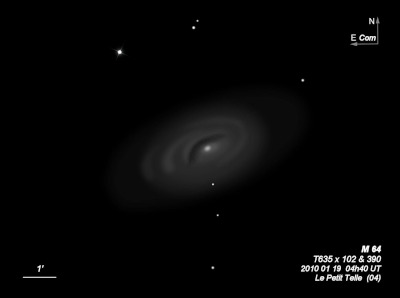
Johann Bode is generally considered the discoverer of M64 = NGC 4826 = h1486 on 4 Apr 1779, but Edward Pigott discovered the Black Eye galaxy a few days earlier on 23 Mar 1779. Charles Messier independently rediscovered it on 1 Mar 1780. Pigott's discovery was announced in Philosophical Transactions of the Royal Society of London, Vol. LXXI (1781), p82-83, but was generally missed until 2002. See http://www.seds.org/messier/more/m064_pigott.html for more of the story.
The nickname "Black-eye" is from William Herschel's description on 13 Feb 1787 (sweep 699): "A very remarkable object, mE about 12' long, 4 or 5' broad, contains one lucid spot like a star with a small black arch under it, so that it gives one the idea of what is called a black eye, arising from fighting." His earlier observation on 13 Apr 1785 (sweep 398) reads "vB, E from np to sf, about 7 or 8' long and 2' broad. A vB nucleus in the middle, but moonlight and haziness probably lessen its appearance considerably. The nucleus is very small in proportion to the rest and is not round, but irreg elongated in the same direction."
John Herschel described his sketch as follows: "The dark semi-elliptic vacancy (indicated by an unshaded or bright portion in the figure) which partially surrounds the condensed and bright nucleus of this nebula, is of course unnoticed by Messier. It was however seen by my Father, and shown by him to the late Sir Charles Blagden, who likened it to the appearance of a black eye, an odd, but not inapt comparison. The nucleus is somewhat elongated, and I have a strong suspicion that it may be a close double star, or extremely condensed double nebula." So perhaps Blagden first mentioned the term and William liked the analogy used it in his description.
At least 18 observations of the "black eye" were made at Birr Castle. On 11 Mar 1848 (one of the earliest descriptions): "curious circular-shaped nebula, with a dark and large spot at one side, around which is a close cluster of well-defined little stars." Using his 48-inch on Malta, William Lassell's sketch from 22 Apr 1862 showed the "remarkable dark space" as distinctly crescent-shaped and he noted it appeared "as dark as any part of the surrounding sky."
300/350mm - 13.1" (4/29/84): very bright, large, oval 2:1 WNW-ESE, 6'x3', small bright core, almost stellar nucleus. The famous curved dark patch or "Black Eye", located just northeast of the core, was quite prominent and visible with direct vision. Located 55' NE of the tight double star 35 Comae.
Notes by Steve Gottlieb
M 53
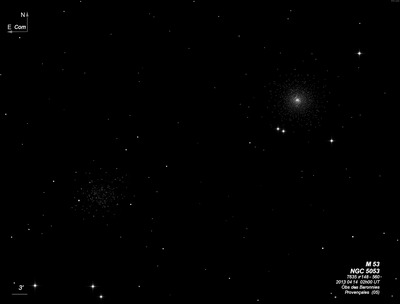
Johann Elert Bode discovered M53 = NGC 5024 = h1558 on 3 Feb 1775. Charles Messier independently discovered it on 26 Feb 1777.
William Herschel made his first observation on 30 May 1783 with his 6-inch and noted "more than a suspicion of stars." On 14 Mar 1784 (sweep 170) he described M53 as "one of the most beautiful objects I remember ever to have seen in the heavens; The cluster appears under the form of a solid ball consisting of small stars quite compressed into one blaze of light, with a great number of loose ones surrounding it and distinctly visible in the general mass. See fig. 2 [which shows it resolved into numerous stars]."
John Herschel described it on 6 May 1826 as "A most beautiful highly compressed cluster. Stars very small, 12...20m; with sc st to a considerable dist; irreg R, but not globular. Comes up to a blaze in the centre; indicating a round mass of pretty equable density." On 25 May 1827, he logged "Seen by Mr. Baily. A fine compressed cluster, with curved appendages like the short claws of a crab running out from the main body."
Wilhelm Struve found it again in 1825 or 1826 and included it in a list of 9 "Nebulae dectae" in the appendix to his main catalogue of double stars. In his 1844 Bedford Catalogue, William Smyth called M53 a "brilliant mass of minute stars" and a "ball of innumerable worlds."
300/350mm - 13.1" (5/21/82): outer halo of faint stars resolved.
400/500mm - 17.5" (5/27/00): at 220x this moderately bright GC appeared 6'-7' diameter with a very bright 2' core and ~50-60 stars resolved. At 380x, perhaps 75 stars were resolved, mostly in the outer halo and the edges of the small, bright, concentrated core. A brighter mag 12 star is just NE of the core, but most of the resolved stars are mag 13.5-15. The halo is fairly rich, but unevenly distributed with more stars resolved on the north side. Towards the edges of the halo the globular thins out and appeared straggly, with a maximum diameter 8'-9'.
17.5" (5/10/86): at least 50 stars resolved mostly in the outer halo which reaches 6' diameter. Contains a very bright core that is very mottled. Many stars are superimposed over the core.
Notes by Steve Gottlieb
M 85
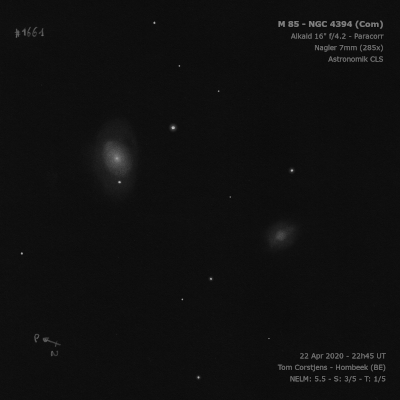
Pierre Méchain discovered M85 = NGC 4382 = h1242 on 4 Mar 1781. William Herschel made an observation on 14 Mar 1784 (sweep 170) and recorded "Two resolvable nebulae; the preceding is the largest and with 157 seems to have another small nebula joining to it [NGC 4394], but with 240 it appears to be a star." John Herschel recorded on 23 Mar 1827 (sweep 61), "vB; R; bM; 2' diam; has a * 80° np dist 30" from edge."
Based on a photograph taken with the Crossley reflector, Heber Curtis called it a "Very bright oval, 4'x2'; very slight traces of spiral structure."
400/500mm - 17.5" (5/23/87): very bright, moderately large, small very bright core. A mag 13 star is superimposed near the NNE edge and a mag 10 star is off the SE side 2.7' from center. Forms a pair with NGC 4394 7.6' ENE.
Notes by Steve Gottlieb
M 100
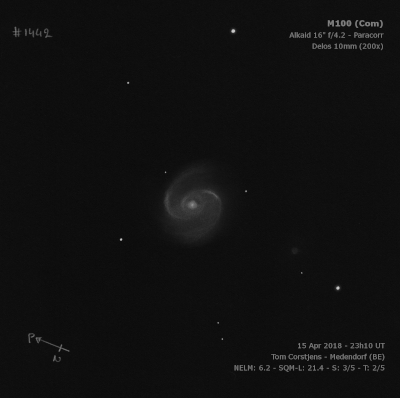
Pierre Méchain discovered M100 = NGC 4321 = h1211, along with M98 and M99, on 15 Mar 1781 and Messier verified it a month later. William Herschel described "a vL nebula of about 10' in diameter, with a small bright cluster of supposed stars in the middle. It is followed at the distance of 6 or 8' by another distinct F, S, R, r nebula [NGC 4328] which is nearly in the same parallel with the great one." His description obviously refers to the sharply concentrated core, though he gave this as an example in his 1814 publication of a nebula probably consisting of a cluster of stars.
Lord Rosse discovered spiral structure in M100 on 9 Mar 1850 (or earlier) and included M100 in his list of "Spiral or curvilinear" nebulae in the 1850 PT paper. William Lassell published two sketches of M100 using his 48-inch on Malta on 24 and 26 Apr 1862. The second one is an excellent rendering of the spiral arms, which both wrap about 1 1/2 revolutions around the core. Dreyer's comment "(L): 2-branched spiral", is based on this sketch.
M101 is one of the largest and brightest spirals in the Virgo cluster. It was the fist Virgo cluster member that the HST observed Cepheid variables (1993) and derived a distance of 55 million light years (since revised to ~50 million light years). Five supernovae have been recorded: 1901B, 1914A, 1959E, 1979C, 2006X. The first two were found on archived plates and announced by Heber Curtis in Lick Observatory Bulletin 300 (1917LicOB...9..108C). SN 1901B was found on a photograph taken on 17 Mar 1901 and SN 1914A was found on a photograph taken 2 Mar 1914.
400/500mm - 17.5" (5/23/87): bright, very large, almost round, well-defined bright core surrounded by a large, fainter halo. Two faint galaxies NGC 4323 and NGC 4328 lie 5' N and 6' E, respectively. This is the brightest spiral in the Coma-Virgo cluster.
900/1200mm - 48" (4/18/15): stunning view of this gorgeous spiral at 375x and 488x. M100 was sharply concentrated with an intensely bright circular nucleus. Two prominent, high contrast arms (fairly narrow) each rotated ~270° and could be clearly traced to within 1' of the center. The south and north outer tips of the arms are between 5.5'-6' apart with the overall size ~6'x5'.
One arm begins off the WNW side of the core with a bright mottled section angling nearly north-south for ~25". This section contains multiple HII sites NGC 4321:[HK83]220/223/229/230 from Hodge and Kennicutt's 1983 "An Atlas of H II regions in 125 galaxies". The arm curls clockwise around the south side. A small (~8" dia.) HII knot (#160/171/172) is within this arm, 1.0' S of center. Just to the east [1.5' SE of center] is a brighter, mottled section that contains a close pair [18" separation] of compact HII knots (#110 and #69/87). The surface brightness of the arm abruptly drops as it shoots due north on the east side of the halo for ~3'. The arm dims further as it curves west on the northeast side of the outer halo and ends just southeast of mag 15 star situated 2.9' NNW of center.
The second arm begins ~1' SE of center as a thicker, much brighter region. The Hodge-Kennicutt Atlas catalogues numerous HII designations in this region, but none stood out individually. The arm sharply narrows and rotates clockwise around the north side of the core towards the west. It passes just south of two mag 15.5 stars, where there is a slightly brighter mottled section containing HII regions #252/253. The arm dims significantly as it heads south on the west side of the halo. Finally, it weakens further and spreads out at the end on the southwest side of the galaxy [2.6' from center].
Notes by Steve Gottlieb
M 88
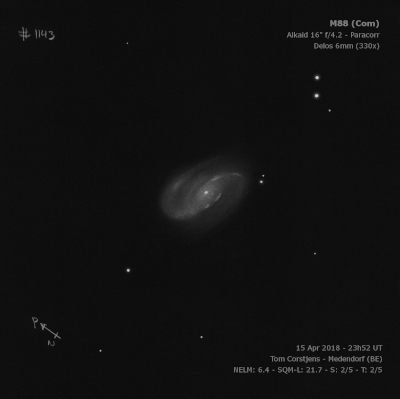
Charles Messier discovered M88 = NGC 4501 = h1312 on 18 Mar 1781. William Herschel described it on 14 Jan 1787 (sweep 691) as "vB, vL, E." JH made 5 observations and recorded on sweep 422 "B; vL; vmE; 8' l, 1' br. The northern half is brighter than the southern." On two other sweeps heaccurately measured the position angle as between 140°-145°. Listed as "Spiral or curvilinear" in Lord Rosse's 1850 PT paper.
At Birr Castle, R.J. Mitchell recorded on 9 Mar 1855 "Another spiral? dark spaces p[receding] Nucl, others also, especially one sf [south-following] Nucl. Six nights later he logged "Thought I could trace a dark passage from south end down past the Nucl. Saw but the one branch f neby outside this passage." William Lassell sketched M88 on 21 May 1862 using his 48-inch on Malta. He noted "this nebula is of a somewhat convoluted form it may be a spiral, but I cannot make it out." Nevertheless, a comparison of his sketch with images, shows the tight set of spiral arms around the core and another spiral arm curling around on the southeast side of the halo.
400/500mm - 17.5" (4/25/87): very bright, very large, elongated 5:2 NW-SE, brighter core, intense very small or stellar nucleus (Seyfert 2 galaxy). A faint double star is embedded at the SE end (mag 13.5/14.5 at 20"). A brighter double star mag 11/12 at 30" is 5' S of center. Located at the NE end of "Markarian's chain" in the core of Virgo cluster.
900/1200mm - 48" (4/5/13): a thin spiral arm was clearly visible extending along the entire western flank of the halo and stretching 4.5' from NW to SE. This arm separates more cleanly from the central region as it extends south, reaching a wide double star (13.7/14.3 that is superimposed on the southeast end. A fainter, very thin, straight arm was also visible along the east side of the galaxy, extending towards the northwest. This arm hugs pretty close to the east side of the core and separates a bit on the north side.
Notes by Steve Gottlieb
M 99
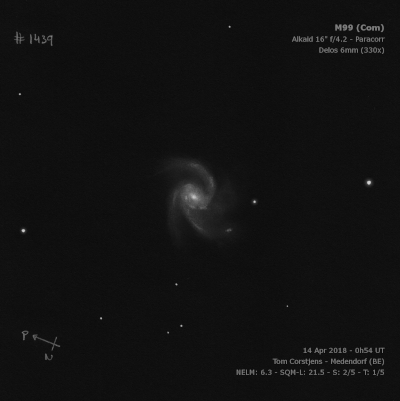
Pierre Méchain discovered M99 = NGC 4254 = h1173 on 15 Mar 1781. William Herschel observed M99 on 14 Jan 1787 (sweep 691) and recorded, "vB. vL. vgmbM, and the brightness taking up a great space. John Herschel logged on sweep 419, "B; R; gbM; r; 5' diam."
William Parsons, the third Earl of Rosse, discovered spiral structure in April of 1846 using the 72" Leviathan of Parsonstown. The observation was made a full year after the spiral nature of M51 was discovered as LdR's attention was diverted to the Irish potato famine. M99 was the second confirmed spiral, though a month earlier NGC 2903 was noted as having a "tendency" to an "annular or spiral arrangement". On 11 Mar 1848, observing assistant William Rambaut described M99 as a "Spiral with a bright star above; a thin portion of the nebula reaches across this star and some distance past it. Principal spiral at the bottom, and turning towards the right.” Lord Rosse’s outstanding sketch showed at least 4 arms. It was published in the Philosphical Transactions of 1850 (plate XXXV, figure 2), alongside his sketch of M51. A good copy of the sketch is at http://www.wsanford.com/~wsanford/exo/rosse/index.html.
William Lassell sketched M99 on 31 Mar 1862 from Malta with his 48-inch and included three principal arms and one or two offshoots . He noted "Viewed with power 285. The spiral form is very evident, more so, I think than in any other nebula I have seen."
300/350mm - 13.1" (4/29/84): bright nuclear region. A spiral arm is easily visible attached at the SE side of core and winding almost 180° to the west. Located 10' SW of mag 6.5 HD 10710.
400/500mm - 17.5" (5/10/86): very bright, large, bright core, stellar nucleus. There is an obvious spiral arm attached at the SE side of the core and winding along the south side towards the west. There is a dark gap between the spiral arm and the core along the south and west side. A second shorter, diffuse arm is visible on the north side.
600/800mm - 24" (5/24/20): at 225x and 375x; relatively large bright circular core, ~1' diameter, increased to a very bright, small mottled nucleus. The irregular outer halo extended ~4' diameter. The brighter and larger arm was easily visible; it emerged from the east side of the core and curved counterclockwise to the south of the core and then extended to the WSW before dimming out. A very subtle brightening or knot was seen within the arm [50" S of center]. A second arm of much lower contrast began on the west side of the core and headed in the NNE direction for ~1.5' before fading into the halo. A very faint knot (NGC 4254:[HK83] 1), was visible in the outer halo on the east side [1.8' ENE of center] and was easily seen with averted. A mag 13.5 star is just outside the halo, 2' ESE of center.
900/1200mm - 48" (4/1/11): stunning view of this beautiful, asymmetric two-armed spiral at 375x. The galaxy is sharply concentrated with a brilliant 1' core that increases to a sharp stellar nucleus. The brighter more open arm is attached on the east side of the very bright core. It unwinds beautifully and expands counterclockwise for ~225° where it ends to the NW of center. As the arm passes south of the core there is a bright, well defined knot (sketched and later measured 0.9' S of the nucleus) with two additional diffuse knots in this arm 1.2' SW of center and 1.9' W of center. The arm continues to sweep north on the west side, where it is well separated from the main body.
A second long sweeping fainter arm is attached on the west side of the core and unfolds counterclockwise towards the NE. It contains a diffuse knot ~1.2' NNW of center and terminates near an ill-defined knot 2' NE of center. The halo of the galaxy is more extensive on this side and contains a prominent knot 1.8' E of center. This knot is at the end of another more ill-defined arm on the north side of the core heading east that contains additional mottled clumps.
Notes by Steve Gottlieb
M 98
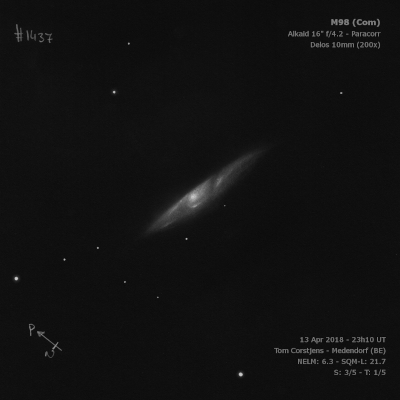
Pierre Méchain discovered M98 = NGC 4192 = h1132 on 15 Mar 1781. Messier made a confirmation a month later. William Herschel observed M98 on 30 Dec 1783 (sweep 73) and recorded "A large, extended, fine nebula. It seems to be M98, but from the description in Connoissance des Temps it appears that Mechain has not seen the whole of it, for its feeble branches extend about 1/4°, of which no notice is taken. Near the middle of it a few stars are visible and more suspected; my field will not quite take it in." John Herschel recorded M98 on 4 sweeps, first describing it on 3 Apr 1826 as "B; vmE; a ray pos 70° sf to np; mbM almost to nucleus; 10' long."
Based on a photograph with the Crossley reflector, Heber Curtis (1918) described M98 as "An open, elongated spiral 8'x2' in p.a. 150°. Bright stellar nucleus; numerous almost stellar condensations. Absorption effects on east side"
300/350mm - 13" (4/29/84): bright, large, very elongated, small bright nucleus, impressive.
400/500mm - 17.5" (5/10/86): bright, very large, very elongated 4:1 NNW-SSE, 6'x1.5', small bright core, stellar nucleus. A faint knot was highly suspected near the south tip. NGC 4186 lies 11' SSE. Located 32' W of 6 Comae Berenices (V = 5.1).
Notes by Steve Gottlieb
M 91
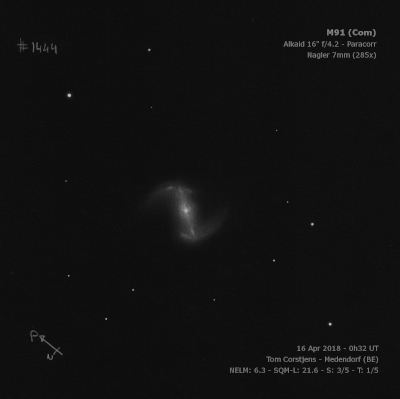
Charles Messier discovered M91 = NGC 4548 = H II-120 = h1345 on 18 Mar 1781. For a long time M91 was a missing Messier object as there is nothing in his position. In "The Missing Messier Objects" (Sky & Tel Oct 1960), Owen Gingerich concluded that M91 was likely a duplicate observation of M58 (same RA as Messier's position for M91 but differs by 2° in dec). Gingrich noted that M91 had been previously proposed to be a comet (suggested by Harlow Shapley and Helen Davis). But in 1969 Texas amateur William C. Williams of Fort Worth figured out that Messier had determined its position using offsets from M89, though he assumed it was from M58. Making this correction, the position of M91 matches NGC 4548.
William Herschel independently found this galaxy on 8 Apr 1784 (sweep 187) and recorded H II-120 as "L, resolvable, but moonlight [end of a long night]." John Herschel made 3 observations, first logging this galaxy on 3 Apr 1826 (sweep 24) as "pB; R; bM; 60" [diameter]."
400/500mm - 17.5" (5/23/87): bright, moderately large, elongated 3:2 SW-NE, 3'x2', gradually increases to a bright core and a very small nucleus. M88 is 50' WSW.
600/800mm - 24" (5/22/17): at 282x; very bright, large, strongly concentrated with a very bright round core that elongates into a bar oriented WSW-ENE. The initial portions of spiral arms are attached at both ends of the bar. On the WSW end, a weak arm extends north, curving slightly counter-clockwise and on the east end, a subtle arm starts to curl south. Both arms blend into a low surface brightness outer halo that extends ~3.5'x2.5'.
CGCG 099-097 was picked up 6.6' SE of the center of M91. At 375x it was very faint, small, slightly elongated SW-NE, ~18"x14", low surface brightness.
Notes by Steve Gottlieb
NGC 4298
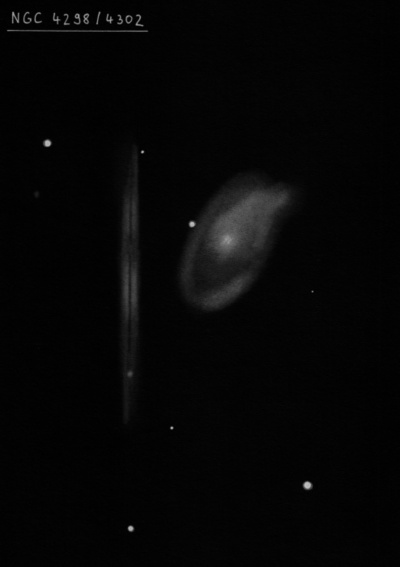
William Herschel discovered NGC 4298 = H II-111 = h1198, along with NGC 4302, on 8 Apr 1784 (sweep 187) and recorded "Two resolvable nebula. The first [NGC 4298] R. The second NGC 4302] E. About 2' from each other. JH noted "F; L; E; vgbM; a star follows; the p of 2."
300/350mm - 13.1" (3/24/84): fairly faint, slightly elongated NW-SE. A mag 13 star is at the east end.
400/500mm - 17.5" (5/23/87): fairly bright, moderately large, elongated NW-SE, broadly brighter center. A mag 13 star is at the east end 0.8' from center. Forms a close pair with edge-on NGC 4302 2' E.
900/1200mm - 48" (4/7/13): very bright, large, oval 2:1 NW-SE, 2.5'x1.5'. Contains a very bright core, which increases to a small bright nucleus. The core is offset a bit to the NW side. The halo extends further to the southeast side and a weakly defined spiral arm is evident in the outer halo on the west side, extending to the southeast end. A mag 13.5 star is at the east side, 0.8' from the core. Forms a striking pair with NGC 4302 2' E. M99 lies 40' WSW.
Notes by Steve Gottlieb
NGC 5053
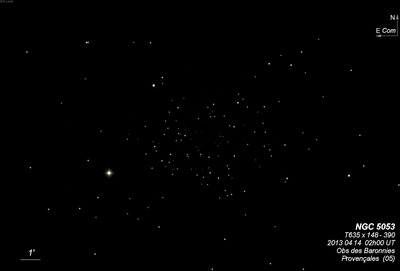
William Herschel discovered NGC 5053 = H VI-7 = h1569 on 14 Mar 1784 (sweep 170) and recorded "an excessively faint cluster of stars intermixed with resolvable nebulosity 8 or 10' diameter. The stars are so small that they cannot be seen without the greatest attention. 240 verified it beyond all doubts." There is nothing at his position, but 2 min of RA west is this low surface brightness globular.
John Herschel described the GC as "vL; eF; a cluster of stars 19 or 20m, with 4 or 5 = 15m; irreg R, vgvlbM; diam at least 8 or 10'. A most curious and interesting object. The stars are just discernable. So faint, might easily be overlooked." He also mentioned the RA of his father was "very much out" so he nearly lost the observation. Dreyer used JH's position in the NGC.
200/250mm - 8" faint, fairly large, pale, no resolution.
400/500mm - 17.5" (5/10/86): about two dozen faint stars resolved at 286x over a faint background haze. Very weak concentration with no core. Appears similar to a faint, resolved open cluster. A mag 9.5 star is off the east side, 6.5' from the center.
Notes by Steve Gottlieb
NGC 4559
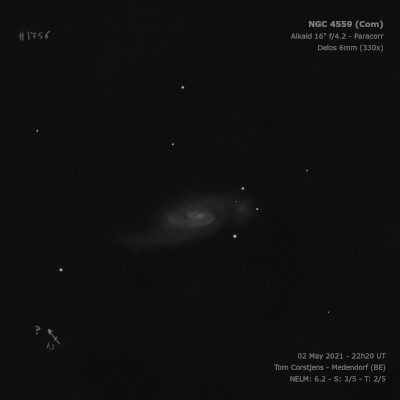
William Herschel discovered NGC 4559 = H I-92 = h1352 on 11 Apr 1785 (sweep 396) and recorded "eB, vL, beautiful. Four stars are scattered over it. pmE from np to sf. The greatest brightness is not in the middle but more towards the following part, where 3 of the 4 stars are placed; the whole extent may be 10 or 12'. JH made 3 observations and logged "vL; gbM, but not to a nucleus; mE; has 3 stars south following. By a diagram, the southern end is broader than the norther, giving it a clubbed appeared."
IC 3550-52, IC 3555, and IC 3563 are HII regions and/or star clouds within NGC 4559 that were discovered photographically by Max Wolf on a Heidelberg plate.
400/500mm - 17.5" (4/9/99): bright, large, elongated 5:3 NW-SE, ~7'x3'. Exhibits a striking, unusual appearance with a broad, weak concentration to a large, elongated core. The overall surface brightness is noticeably irregular with hints of brighter and darker spots. The outer halo has a low surface brightness, particularly on the SE end which is wider than the NW side and shows no tapering. A trio of mag 12-12.5 stars cradle the galaxy at this end and there appears to be mottling near the superimposed stars. NGC 4559 is located exactly 2.0° N of NGC 4565.
900/1200mm - 48" (4/7/13): very bright, very large, very elongated 3:1 NW-SE, 9'x3', large bright core that gradually increased to the center. The core appeared irregular, mottled and dusty. The inner portion of the disc showed weak spiral structure. At 488x, the outer halo was very patchy with several knots. Superimposed on the southeast side are three mag 12/12.5/13 stars between 1.5'-2' from center and the galaxy faded out rapidly beyond these stars to the southeast. Near the southeast end is IC 3563, a very compact HII region and IC 3564, a star association attached on the east side. Both objects were easily visible but merged as a fairly faint 20" patch, 3' SE of center.
The outer halo faded out gradually and extended much further on the northwest side, up to 5' NW of center. IC 3555 is faint, 20"x10" HII region, extended NW-SE, and situated 1.8' NNW of center in the halo. IC 3552, a smaller HII region close NW, was not seen. IC 3551 seen as a faint, 10" HII knot on the west edge, 0.9' WNW of center. IC 3554 is a mag 15 star 2.1' SSW of center (at the edge of the visible disc) and IC 3550 = NGC 4559C was seen as a faint, 8" HII knot 0.8' WNW of the star. All of the IC numbers were found by Max Wolf on a Heidelberg plate in 1903.
Notes by Steve Gottlieb
NGC 4725
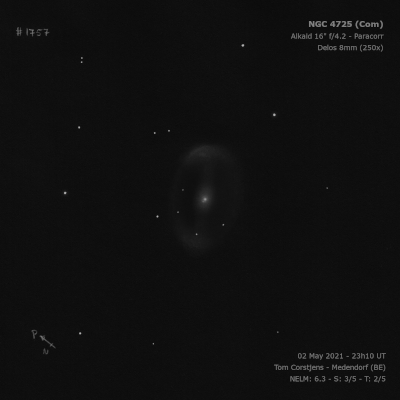
William Herschel discovered NGC 4725 = H I-84 = h1451 on 6 Apr 1785 (sweep 393) and recorded "cB, iR, 7 or 8' the longest way, the brightness confined to a small spot; the rest being milky nebulosity."
Johnstone Stoney, Lord Rosse's assistant, discovered spiral structure on 9 Mar 1850. NGC 4725 was included in the list of "Spiral or curvilinear" nebulae in LdR's 1850 PT paper. The following February, Bindon Stoney logged "Spiral, 2 arms and some stars in following arm." On 15 Apr 1858, R.J. Mitchell wrote "vL and vB. The centre itself it like an E neb with Nucl; the centre is enveloped is an irr ring or rings of nebulous light as in the accompaning rude sketch, which does not contain all the details." His sketch clearly shows the inner ring was resolved. On 3 May 1858, he added "The surrounding ring of nebulosity is of irregular shape, it curves gently at delta (south preceding end) but bends more sharply at gamma (north following end), where it is brightest. The centre seems to reach up to and to blend with the nebulosity at delta."
300/350mm - 13.1" (5/26/84): very bright, impressive, very small bright core, elongated SW-NE, large halo. Structure is suspected with the WSW edge possibly brighter. NGC 4712 lies 12' WSW.
400/500mm - 18" (5/12/07): very impressive spiral structure visible. Two arms emerge from the very bright oval core. One arm is attached at the northeast end of the core and sweeps to the north before hooking back to the west. Three faint stars are superimposed along this arm. A second broader arm is attached at the southwest end of the core. This arms heads south before hooking towards the east. Both arms have brighter patches or arcs near the ends of the major axis.
900/1200mm - 48" (5/3/19): very bright, very large, oval 3:2 SSW-NNE, strong concentration with a very bright oval core and an intense nucleus. The inner ring (interpreted as spiral arms in my 18" observation) was very obvious and highlighted by bright arcs or "handles" at the southwest and northeast ends. The ring dimmed on the east side but could be traced between the two arcs. The western side, though, had a missing gap. At least one HII knot was seen on the SW end [2.1' WSW of center], perhaps NGC 4725:[BKB2006] 11, which is in the spiral arm immediately to the west. A faint HII region was also noted on the NE end of the ring, probably NGC 4725:[BKB2006] 4. These designations are from a 2006 catalog of HII regions by Bradley et al.
Notes by Steve Gottlieb
NGC 4153
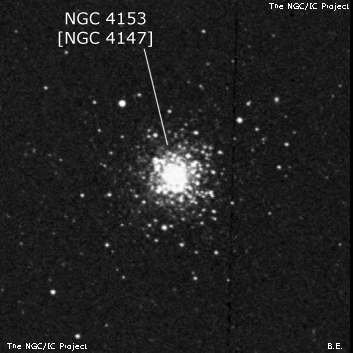
400/500mm - 17.5" (4/13/96): moderately bright, fairly small, irregular 2'-2.5' diameter, very small bright core. A few faint stars are resolved at 220x including one brighter star at the south edge. Appears on the verge of more extensive resolution. At 280x, the halo clearly has an irregular outline and several stars are resolved in extensions or star lanes. The core is mottled and intense but not resolved.
17.5" (3/20/93): fairly bright, moderately large, round, 2.5' diameter. Approximately six faint stars are just resolved around the edges of the halo including a single easy mag 14 star at the SSW edge. The compact core is mottled and clumpy but has no clean resolution. There is an impression of several star lanes in the halo just below the limit of resolution.
900/1200mm - 48" (4/22/17): NGC 4147, a class IX globular, was well resolved and impressive at 488x. It appeared very bright, fairly large, large bright core. Over 100 stars were resolved including a number of relatively bright 14.5-15.5 stars. The stellar density increases significantly towards the center where a large number of resolved stars are packed over a hazy, mottled background. The loose halo was well resolved, a bit scraggly around the edges and extended to ~5' diameter. The superthin galaxy UGC 7170 lies 18' NNE.
Notes by Steve Gottlieb
NGC 4414
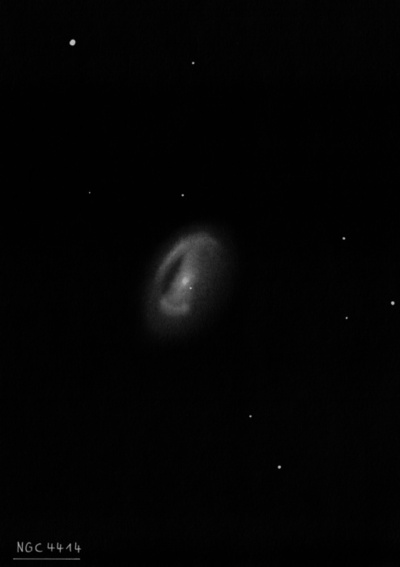
William Herschel discovered NGC 4414 = H I-77 = h1258 on 13 Mar 1785 (sweep 387) and recorded "vB, L, E, broadly [concentrated] to a mbM." JH made two observations and logged (sweep 342) "vB; L; pmE; first gb and the vsvmbM to a nucleus = 11m; 3' l, 90" br."
Spiral structure was not described at Birr Castle, though on 12 Apr 1849, LdR or assistant George Stoney recorded "uncertain whether double nucleus or nucleus and star; neby decidely darker in middle, following the nucleus and rather brighter outside this." The 7 Mar 1856 observation by R.J. Mitchell also mentions "Has a double nucl or a nucl and a star which are excentric, being nearer the sp side; light uneven and patchy. I suspect especially a darkness north of the main nucleus."
200/250mm - 8" fairly bright, elongated NW-SE, small bright nucleus.
400/500mm - 17.5" (4/25/98): bright, elongated NNW-SSE, ~3'x2'. Sharp concentration with a prominent rounder core which increases to a stellar nucleus. There appears to be a sharper light cutoff along the preceding edge and an hint of spiral structure in the outer halo. Observation hampered by hazy skies.
Notes by Steve Gottlieb
NGC 4689
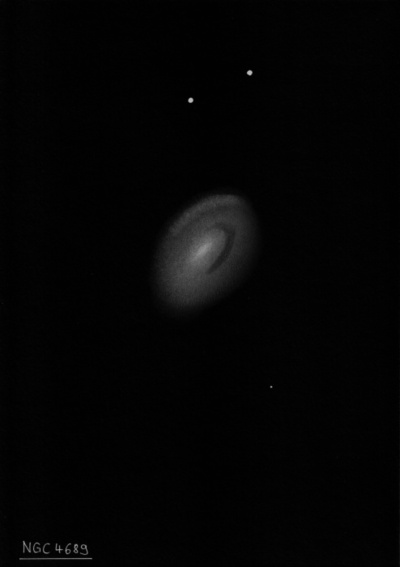
William Herschel discovered NGC 4689 = H II-128 = h1431 on 12 Apr 1784 (sweep 189) and logged "L, R, bM, r." JH made 3 observations and measured an accurate (mean) position.
On 29 Apr 1851, LdR assistant Bindon Stoney recorded "vF, gbM, edges fade off. I fancied a dark space p the central portion." A few nights later he noted "F, suspected spiral."
400/500mm - 17.5" (5/14/94): fairly bright, fairly large, elongated 3:2 WNW-ENE, 3'x2', large diffuse halo, weak concentration, ill-defined brighter core, possible mottling. A pair of mag 11.5/12 stars with separation 1.2' (parallel to the major axis) are located 3.5' N. At 280x, a 1.0' core is more prominent and the outer halo become becomes difficult to view. At low power, forms the northern vertex of a triangle with 28 Comae Berenices (V = 6.6) 14' SSE and mag 8.2 SAO 100258 14' SW.
Notes by Steve Gottlieb
NGC 4064
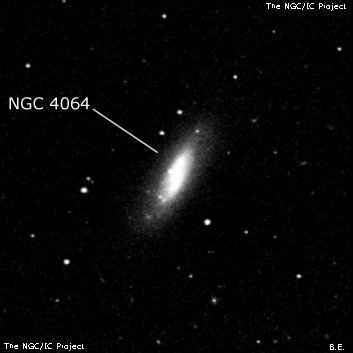
Heinrich d'Arrest discovered NGC 4064 on 29 Dec 1861 with the 11-inch refractor at Copenhagen. His single position matches UGC 7054 and he accurately placed the mag 14 star 82" southwest. This is an unusually bright galaxy to have been missed by both Herschels.
400/500mm - 17.5" (4/6/91): moderately bright, fairly small, elongated 2:1 NW-SE, 3'x1.5', large bright core but no nucleus, sharper light cut-off on the SW side due to dust. Two mag 14 stars are 1.6' SSW and 2.7' E of center.
Notes by Steve Gottlieb
NGC 4450
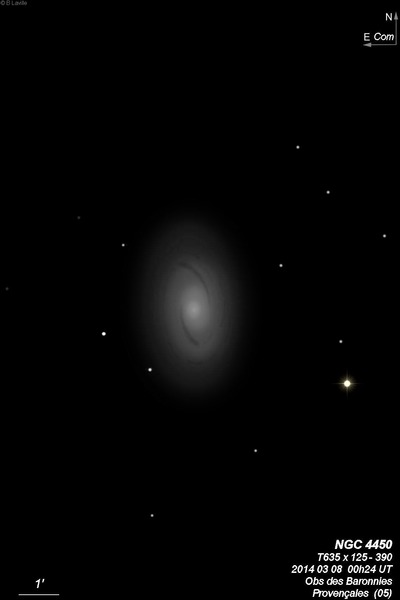
William Herschel discovered NGC 4450 = H II-56 = H II-90 = h1282 on 14 Mar 1784 (sweep 170) and recorded "A resolvable nebula of an irreg shape of about 2 or 3' diam. It is near a pB star." CH's reduced position is 30 sec of RA preceding and 2.4' north of UGC 7594. He recorded it again a week later on sweep 182 as "pL, r, bM", measured an accurate position, and noted this nebula was observed in sweep 170. But his next entry (H II-90) was placed 1.0 min following and there is only one galaxy here, so he must have recorded NGC 4450 a second time in the sweep! JH made 8 observations, apparently looking for a second nebula, but found only one and combed the two H-designations in the GC.
400/500mm - 17.5" (5/23/87): bright, fairly large, elongated 2:1 N-S, 4'x2', diffuse halo, increases suddenly to a high surface brightness core. Located 3.9' NE of mag 8.9 SAO 100115.
Notes by Steve Gottlieb
NGC 4278
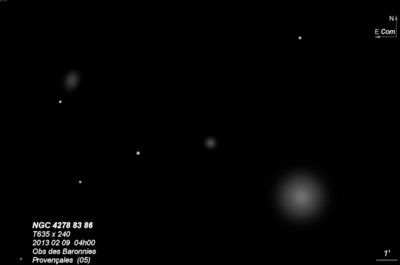
William Herschel discovered NGC 4278 = H I-90 = H II-322 = h1186 on 13 Mar 1785 (sweep 387) and recorded II-322 as "Three [with NGC 4283 and 4286], all in a row, but of unequal size and brightness. The most following [NGC 4286] vF." His single position is 14 sec of time following NGC 4278. He found NGC 4278 again a month later (11 Apr), assumed it was new and recorded I-90 as "Two [with NGC 4283], the time is that of the brightest and preceding [NGC 4278], which is cB, pL, nearly R. The other is sf, pB, S, about 6' distance." JH made two observations and measured an accurate position.
400/500mm - 17.5" (4/25/98): bright, roundish, fairly large, the outer halo increasing to ~3.5' diameter with averted vision. The halo surrounds a well-defined very prominent core which increases to a quasi-stellar nucleus. Forms a pair with NGC 4283 3.5' NE. Poor transparency.
Notes by Steve Gottlieb
NGC 4473
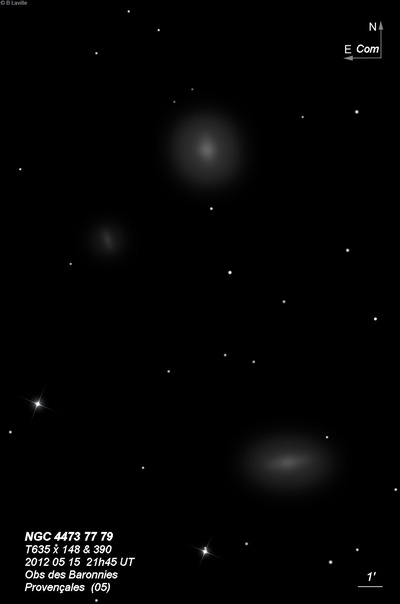
William Herschel discovered NGC 4473 = H II-114, along with NGC 4477 and NGC 4479, on 8 Apr 1784 (sweep 187) and simply noted "F, resolvable." His position (CH's reduction) is 10 sec of RA too large.
Heinrich d'Arrest independently found NGC 4473 and 4477 on 29 Mar 1856, unaware of WH's prior discovery. JH responded in an open letter to Hind that both of d'Arrest's "novae" were seen earlier and that he was surprised d'Arrest missed NGC 4479. This caused some controversy whether NGC 4479 was a "variable" nebula.
300/350mm - 13.1" (5/14/83): bright, elongated E-W, small very bright nucleus.
400/500mm - 17.5" (4/25/87): bright, fairly small, elongated 2:1 ~E-W, small but intense core, stellar nucleus. NGC 4477 lies 13' N.
600/800mm - 24" (5/29/14): bright, fairly large, elongated 2:1 E-W, 2.0'x1.0', sharply concentrated with an intensely bright core that increases to a quasi-stellar nucleus.
Notes by Steve Gottlieb
NGC 4274
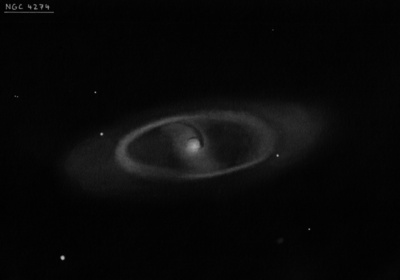
William Herschel discovered NGC 4274 = H I-75 = h1185 on 13 Mar 1785 (sweep 387) and simply noted "vB". JH made the single observation "vB; vL; E in parallel (E-W); 2' l, 1.5' br." On 24 Apr 1849, LdR or assistant George Stoney suspected a "faint tail following". This probably refers to part of the ring surrounding the core.
400/500mm - 17.5" (4/25/98): bright, very large, elongated 5:2 ~E-W, ~5'x2' though difficult to trace the full extent as the outer halo fades into background. Well concentrated with a bright roundish core ~1' diameter which increases to a very small or stellar nucleus. NGC 4253 lies 22' NW, NGC 4245 29' W and NGC 4278/NGC 4283/NGC 4286 ~20' SSE. Observation in hazy skies.
Notes by Steve Gottlieb
NGC 4293
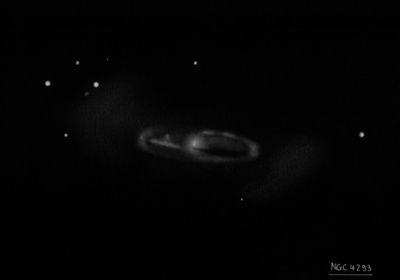
William Herschel discovered NGC 4293 = H V-5 = h1195 on 14 Mar 1784 (sweep 170) and recorded "L, E, r, 6 or 7' in length." JH made two observations and logged (sweep 61) "F; vL; E; bM; 5' l, 1.5' br." Bindon Stoney, LdR's assistant on 10 Apr 1852, noted a "faint knot at end of the preceding branch."
400/500mm - 17.5" (5/23/98): fairly bright, large, elongated 3:1 WSW-ENE, ~4.5'x1.5'. The core is more oval, ~1.2' diameter. The galaxy has an irregular surface brightness and there appears to be a dark band following the core. A mag 13.5 star is just off the following end 2.7' from center and a trio of mag 12-13 stars are off the NE end as well as another mag 13 star 2' N of center. Located 36' N of 11 Comae Berenices (V = 4.7).
Notes by Steve Gottlieb
NGC 4459
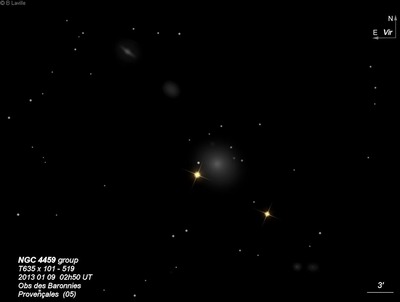
William Herschel discovered NGC 4459 = H I-161 = h1288 on 14 Jan 1787 (sweep 691) and recorded "vB, pL, iR." His position is accurate. JH logged (sweep 23) "pB; R; bM; r; has a *8m 2' dist; 45° sf."
300/350mm - 13.1" (5/14/83): fairly bright, small, slightly elongated, small bright nucleus.
400/500mm - 17.5" (4/25/87): bright, fairly small, slightly elongated ~E-W, bright intense compact core, stellar nucleus. Located 2.2' NW of mag 8.1 SAO 100121. NGC 4468 lies 8.7' NE and NGC 4474 is 14' NE. A close pair, NGC 4446 and NGC 4447 lies 13' WSW.
600/800mm - 24" (5/29/14): very bright, moderately large, slightly elongated 5:4 ~E-W, ~1.5'x1.2', sharply concentrated with a small intensely bright core, stellar nucleus, appears mottled near the core. The halo increases in size with averted. Mag 8.7 HD 108676 lies 2.2' SE of center.
Notes by Steve Gottlieb
NGC 4314
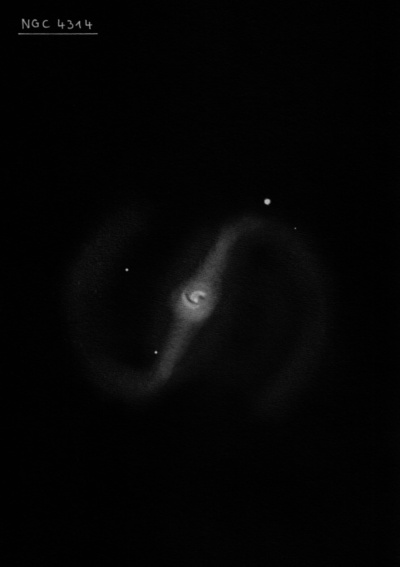
William Herschel discovered NGC 4314 = H I-76 = h1204 = Sf 20 on 13 Mar 1785 (sweep 387) and recorded "cB, L, E." His position matches UGC 7443. Truman Safford rediscovered this galaxy on 16 May 1886 with the 18.5" Clark refractor at the Dearborn Observatory, though noted "vB, probably well known."
400/500mm - 17.5" (4/25/98): fairly bright, fairly large, elongated ~3:1 NNW-SSE, ~3'x1' [prominent central bar]. The halo fades at the tips and rises fairly abruptly to an oval core. A mag 13 star is at the northwest tip and a mag 14/15 star is embedded on the southeast side. The observation was hampered by poor transparency and the faint outer halo of this barred spiral was not seen.
Notes by Steve Gottlieb
NGC 4710
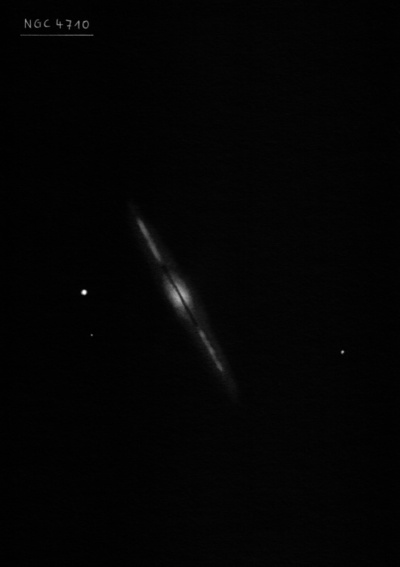
William Herschel discovered NGC 4710 = H II-95 = h1441 on 21 Mar 1784 (sweep 182) and noted "pB, vmE. The direction of extent is nearly in the meridian or perhaps about 5 or more degree sp and nf." His position was poor, but JH observed the galaxy twice, noting "vB; vmE; pos = 28.5° by micrometer; bM; 90" long" and measured an accurate position.
A total of 12 observations were made at Birr Castle. On 16 Feb 1855, R.J. Mitchell wrote "vB ray, a dark band across on each side of nucleus, separating it from the extremities." The dark lane was commented on in each observation. On 16 Apr 1855, he wrote "My sketch exaggerates the dark lines, they should be broader and not so well defined. Mr. Johnstone Stoney [visiting between professorial duties] remarked a second dark line across the n branch near its extremity." On 13 Apr 1876, Dreyer logged "cB, pL, bM, no very defined Nucl, E 28.2°, about 230" long. On both side of Nucl are dark bands. The n end of neb is brighter than s one and the maximum of brightness is about 40" from the end. Maximum in s part is nearer the nucleus. Centre looks a little oval with higher power."
400/500mm - 17.5" (5/14/94): beautiful edge-on 5:1 SSW-NNE (PA 30°), bright bulging core. Distinctly mottled with an irregular surface brightness and clearly brighter along the NNE extension. A mag 13 star is 1.4' E of center. At 280x, the dimensions are 3.5'x0.6' and the galaxy appears to have a sharper light cut-off along the preceding edge possibly due to dust. Very mottled with a couple of bright and dark patches along the major axis. IC 3806 lies 19' SW.
Notes by Steve Gottlieb
NGC 4377
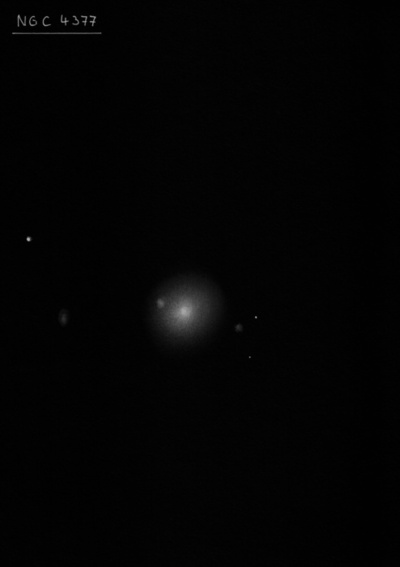
William Herschel discovered NGC 4377 = H I-12 = h1239 on 19 Feb 1784 (sweep 149) and recorded "pB, but not vL; I saw it only through a very strong haziness and only a single moment." JH made the single observation "B; S; vsmbM" and measured an accurate position.
400/500mm - 17.5" (5/23/87): moderately bright, fairly small, almost round or slightly elongated N-S, small very bright core, stellar nucleus.
Notes by Steve Gottlieb
NGC 4747
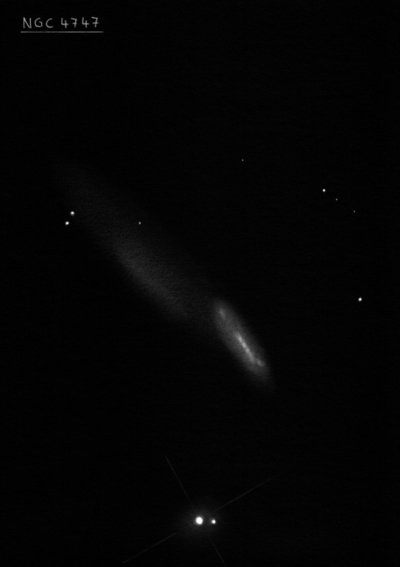
William Herschel discovered NGC 4747 = H II-344 on 6 Apr 1785 (sweep 393) and noted "F; pL; lE." CH's reduction is 1' south of UGC 8005. Although JH recorded nearby NGC 4725, though either missed or didn't look for this object.
300/350mm - 13.1" (5/26/84): fairly faint, moderately large, very elongated 3:1 SW-NE, 3'x1', diffuse, low even surface brightness. Located 22' NE of NGC 4725.
Notes by Steve Gottlieb
NGC 4017
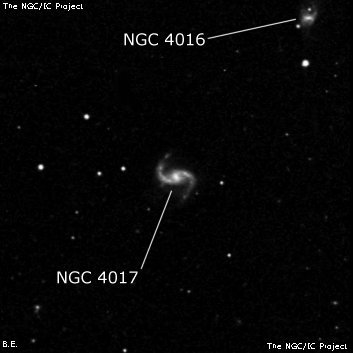
William Herschel discovered NGC 4017 = H II-369 = h1043 on 11 Apr 1785 (sweep 396) and noted "F, E, pL. The following part the brightest." CH's reduction matches this barred spiral. JH made three observations, although all positions are rough.
Six observations were made at Birr Castle. On 30 Mar 1854, R.J. Mitchell noted "F, spiral? Another vF neb [NGC 4016] about 5' np or nearly north." The following spring he commented "Query, shaped like an "S"? Its light is certainly patchy and the neb is lE nearly pf. np this object is another F, R neb with stellar centre." Finally on 16 Apr 1855, he wrote "my previous conjectoure as to shape is rather confirmed by Mr. Johnstone Stoney [on a visit between professorial duties], who saw the p branch turned off sharply to the south, while the f bend is not so sharp, but this latter branch reacher farther round and is rather fainter."
CGCG mislabels NGC 4017 as[NGC 4016.
400/500mm - 17.5" (4/9/99): fairly faint, elongated 3:2 WSW-ENE, 1.2'x0.8', weak concentration [face-on SBc spiral]. Forms a pair with NGC 4016 6' NW.
900/1200mm - 48" (4/20/17): at 488x; beautiful 2-armed spiral with a very distinctive "S" shape. Contains a bright, elongated core or bar oriented E-W, though it was not as narrow as a typical bar. It brightened somewhat in the center to a rounder nucleus. Two very easy, graceful spiral arms were visible; the eastern arm is a bit brighter and knotty (HII regions) near its root on the southeast side of the core. It rotates clockwise, bending north on the east side of the galaxy and then curls towards to the west, ending nearly due north of the core. The western arm was also easily seen as an extension south-southeast, while tapering and fading to the south of the core. Forms a striking pair with NGC 4016 6' NW.
Notes by Steve Gottlieb
NGC 4494
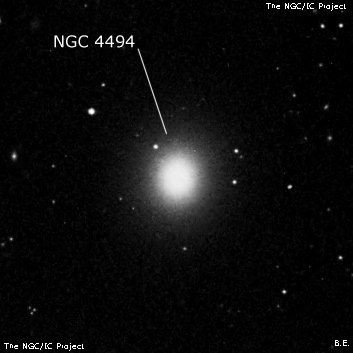
William Herschel discovered NGC 4494 = H I-83 = h1307 on 6 Apr 1785 (sweep 393) and recorded "cB, pL, mbM, iR." John Herschel noted "vB; R; vsmbM to a nucl; 40-50" dia."
400/500mm - 18" (4/5/03): very bright, fairly large, slightly elongated ~N-S, ~3'x2.4', sharply concentrated with a very bright 20" core which increases to center. The halo gradually fades and increases in size with averted vision. Located 6' SSW of mag 7.9 HD 109030 and 35' ESE of the wide binocular pair 17 Coma.
Notes by Steve Gottlieb
NGC 4098
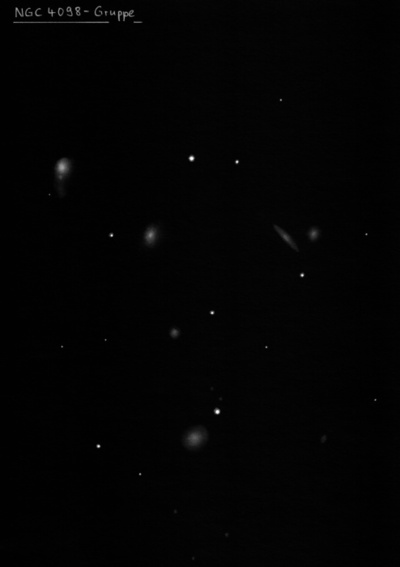
400/500mm - 17.5" (5/14/88): fairly faint, fairly small, round, bright core. Last and brightest of six in the field within the NGC 4065 cluster. Appears slightly brighter than NGC 4092 8.4' SSW.
Notes by Steve Gottlieb
NGC 4615
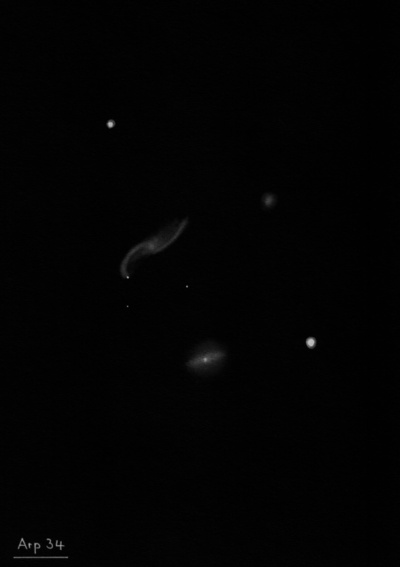
Heinrich d'Arrest discovered NGC 4615 = Sf 12, along with NGC 4613 and NGC 4614, on 9 May 1864 with the 11-inch refractor at Copenhagen. His position (measured on two nights) matches UGC 7852. Truman Safford independently discovered NGC 4615, as well as NGC 4614, on 11 May 1866.
400/500mm - 17.5" (4/6/91): faint, fairly small, elongated 3:2 NW-SE, even surface brightness. Third and largest of three with NGC 4614 2.5' SW and NGC 4613 2' WNW.
600/800mm - 24" (6/1/13): largest in a small triplet with NGC 4613 2.1' NW and NGC 4614 2.2' SW. Fairly faint to moderately bright, very elongated 3:1 NW-SE, 1.5'x0.5', weak concentration. This is a nice little trio forming a small isosceles triangle with NGC 4615 at the eastern vertex. NGC 4615 is in Arp's category of "Integral Sign" galaxies.
Notes by Steve Gottlieb
NGC 4211
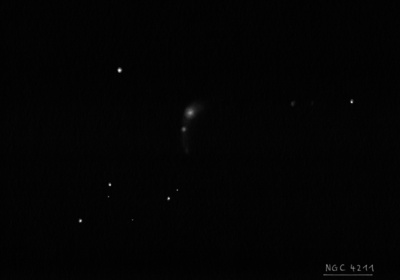
Édouard Stephan discovered NGC 4211 = St XI-18 on 30 Apr 1881. His position matches UGC 7277 = Arp 106.
400/500mm - 18" (4/5/03): faint, very small, round, 25" diameter. This is a double, interacting system (Arp 106) with a small, faint companion 0.55' SE. At 300x, the companion (VV 196b) appeared extremely faint and small (0.2' diameter) and just resolved from NGC 4211. A mag 12.4 star lies 2.8' NE. Third of three with NGC 4196 and NGC 4185 20' NW and 35' NW, respectively.
600/800mm - 24" (5/30/16): NGC 4211 is an interacting system (Arp 106) oriented NW-SE (separation 35"), with the brighter component (VV 196a) on the northwest side. At 225x it appeared fairly faint to moderately bright, round, 24" diameter, increases rapidly to a very small brighter core and stellar nucleus. The fainter southeast component (NGC 4211A = VV 196b) is faint, small, slightly elongated N-S, 15"x10", slightly concentration at the center. The tidal tail to the south was not seen. Situated 9' NW of mag 8.2 HD 106678.
UGC 7287 lies 8' SE. It appeared faint, fairly small, slightly elongated E-W, 24"x18", low even surface brightness.
Notes by Steve Gottlieb
NGC 4016
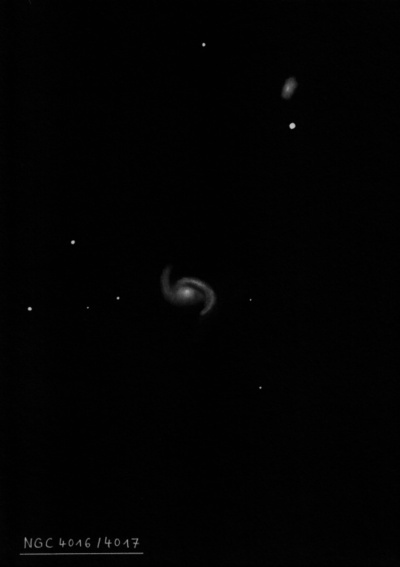
R.J. Mitchell, LdR's assistant, discovered NGC 4016 at Birr Castle on 30 Mar 1854 and noted "another vF neb about 5' np or nearly north [of NGC 4017]." At this offset is UGC 6954. The following April this galaxy was also noted as "np NGC 4017] is another F, R neb with stellar centre." The CGCG confuses the identifications of NGC 4016 and 4017.
400/500mm - 17.5" (4/9/99): faint, fairly small, elongated ~ E-W, 0.8'x0.5', no noticeable concentration. A mag 12 star lies 1.3' S of center. First and fainter of pair with NGC 4017 6' SE.
900/1200mm - 48" (4/20/17): at 488x; moderately bright and large, slightly elongated but irregular shape. Contains a brighter elongated bar through the center oriented ~E-W with a slightly brighter, very small nucleus. The halo changed shape and size with averted version so I was probably picking up part of the spiral arms that extend north on the west side and south on the east side. The "bowtie" structure visible around the bar on the SDSS was not seen. A mag 17.3 star is superimposed just 15" N of center and a mag 16.2 star is at the southeast edge of the galaxy. Forms a pair (Arp 305) with NGC 4017 6' SE.
Notes by Steve Gottlieb
NGC 5012A
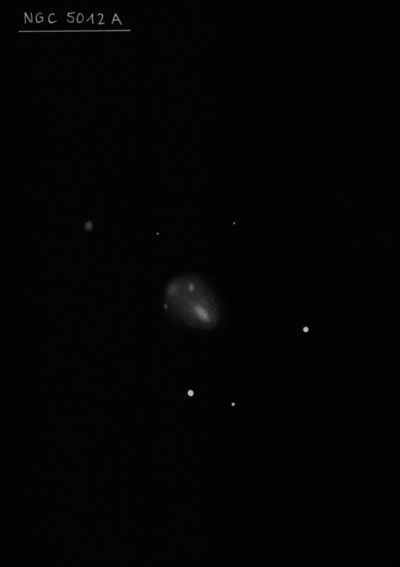
At 488x, the core (assigned a MAC designation in Megastar) appeared moderately bright, elongated 3:2 SW-NE, 0.3'x0.2', fairly high surface brightness. Extending to the northeast is a large, low surface brightness halo, which appeared irregular and knotty. This offset halo increased the overall size of the galaxy to ~1.2'x0.8'. On the east end of the halo is a nearly stellar 16-17th mag knot [SDSS J131245.19+224959.0 at 50" ENE of the core]. A second low surface brightness knot is at the northeast edge [SDSS J131244.92+225018.0 at 1.0' NE of the core]. A third very low contrast knot is 40" NE of the core (SDSS J131243.49+225018.1). The SDSS image reveals these are the brightest of a large number of blue knots.
PGC 1677429 = 2MASX J13124913+2251519 lies 2.6' NE and appeared faint, small, round, 18" diameter. No redshift is given in NED or SDSS for this galaxy (brighter member of an interacting pair with tidal tails), so I don't know if it's related to VV 559, although it's aligned with its major axis.
900/1200mm - 48" (4/7/13): I ran across this object in Vorontsov-Velyaminov's paper "Nine enigmatic new objects" (Soviet Astronomy Letters, vol. 1, p.23, 1975). He nicknames it the "Sign" and describes "Four condensations are so arranged as to resemble a cross. The knot at the apex is a double, while the one at the bottom of the cross is elongated and larger than the others. The space between them is filled with bright diffuse radiation. Especially remarkable is the fact that this radiation gives the impression of streamers everywhere directed towards the brighter condensation. The diffuse and amorphous appearances of all the knots indicates that this complex is galactic in nature." In his 1975 "Atlas of Interacting Galaxies, Part 2", the nickname "Apparition" is given.
Notes by Steve Gottlieb
NGC 4676A
Rudolph Spitaler resolved IC 819 and 820, the two components of the "Mice", on 20 Mar 1892 using the 27" Grubb refractor at Vienna. His position is exactly 1 min of RA too far east, so he made a digit error in computing or copying the position. Gerard de Vaucouleurs used the letter suffixes NGC 4676A and 4676B in the 1956 "Survey of Bright Galaxies South of -35° Declination", based on Mt Stromlo plates, and the 1964 "Reference Catalogue of Bright Galaxies".
400/500mm - 17.5" the northwest member (IC 819) of the interacting pair "The Mice" appeared faint, small, low surface brightness, elongated N-S.
600/800mm - 24" (5/22/17): IC 819 = NGC 4676A is the slightly fainter northwest component of the interacting "Mice" duo. At 375x it appeared faint to fairly faint, small, slightly elongated, 15" diameter. The tidal tail was easily seen as a straight thin extension due north, so the combined galaxy/tail extended ~60"x10". The tail has only a slightly lower surface brightness than the "head" (core of the galaxy).
900/1200mm - 48" (4/6/13): IC 819 is the NNW component of a fascinating interacting pair with IC 820 (slightly brighter SSE component), separated by 40" between centers. At 375x and 488x in soft seeing, IC 819 appeared fairly bright, small, elongated 3:2 N-S, 24"x16", high surface brightness. IC 820 was bright, fairly small, elongated 3:2 SW-NE, 30"x20", high surface brightness, increased to a small, very bright nucleus. The two galaxies are connected or surrounded by a low surface brightness bridge. IC 819 has a remarkable bright, long thin tidal tail shooting due north! The tail has a high surface brightness (brightest feature of this type I've observed in any galaxy) and extends roughly 80"x8", dimming at the north end and ending just east of a mag 17.3 star.
Notes by Steve Gottlieb
Mel 111
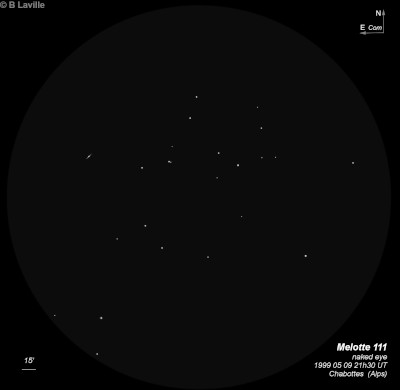
| Type | OC [II3p] |
| RA | 12:25:06.0 |
| Dec | +26:07:00.0 |
| major_axis | 275.0' |
| mag | 1.8 |
Abell 1656
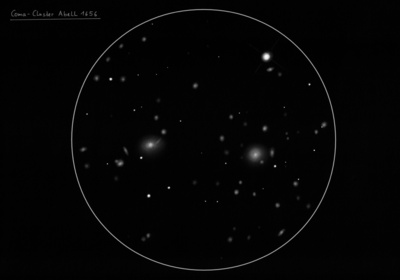
| Type | GALCL [21II] |
| RA | 12:59:48.0 |
| Dec | +27:59:00.0 |
| major_axis | 224.0' |
| mag | 13.5 |
UGC 7576
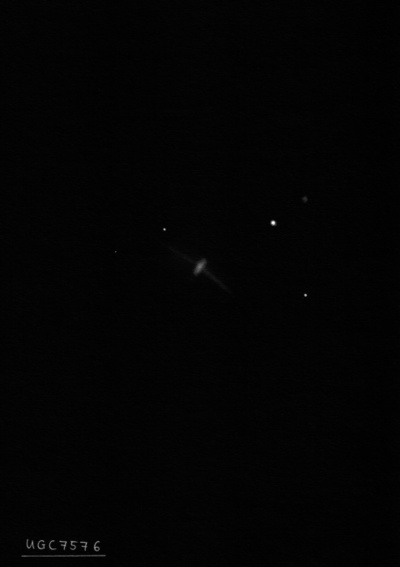
| Type | GX |
| RA | 12:27:41.5 |
| Dec | +28:41:25.0 |
| major_axis | 90.0'' |
| minor_axis | 30.0'' |
| position_angle | 54.0 |
| mag | 14.4 |
